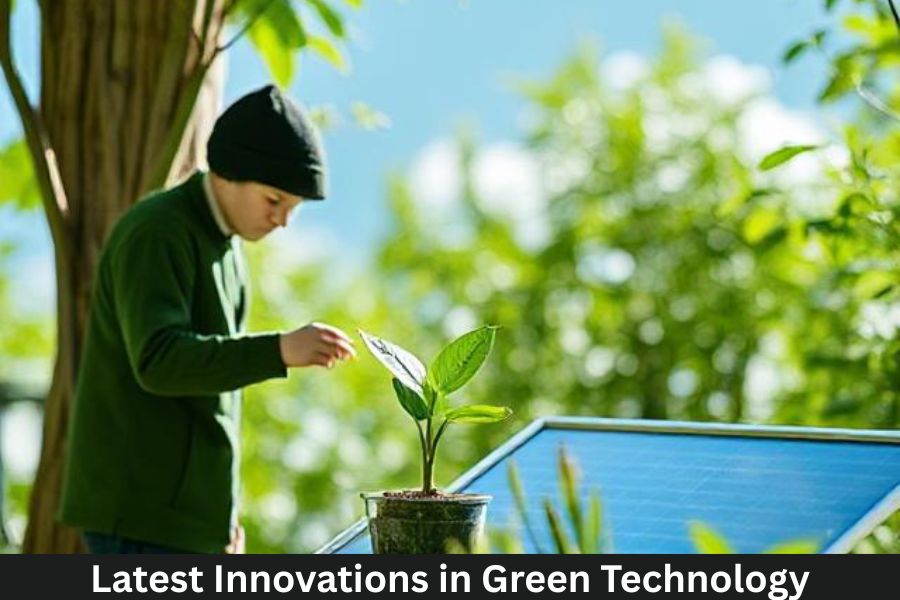Green technology, also known as environmental or sustainable technology, is rapidly advancing to help tackle climate change and reduce environmental impact. As concerns about the planet’s future grow, new innovations are emerging at an unprecedented rate, offering exciting opportunities to mitigate environmental damage and create a more sustainable future. In this article, we will explore the latest breakthroughs in green technology and how they are shaping the world for a better tomorrow.
Introduction
The global push for sustainability has led to incredible innovations in various sectors, from energy production to waste management and beyond. Green technology focuses on using natural resources efficiently, reducing carbon emissions, and promoting environmental protection. As the world faces pressing issues like pollution, climate change, and the depletion of natural resources, these innovations are vital for creating a cleaner, greener planet. In this article, we’ll dive into some of the most exciting and impactful green technology trends that are driving change.
The Need for Green Technology
Before diving into the innovations themselves, it’s crucial to understand why green technology is so important. Our planet faces challenges like:
- Climate Change: The rise in global temperatures due to excessive carbon emissions.
- Pollution: Harmful emissions and waste from industries and transportation.
- Depletion of Resources: Overuse of fossil fuels and other non-renewable resources.
Green technology offers a way forward by providing alternatives to traditional energy and resource consumption, promoting sustainability, and ensuring a cleaner future for generations to come.
1. Solar Energy Advancements
Solar energy has been a cornerstone of green technology for years, but recent innovations are pushing it to new heights.
1.1. Solar Roofs and Solar Windows
Traditional solar panels are effective, but the latest innovations aim to make solar power more accessible and aesthetically pleasing. Solar roofs and solar windows are emerging as game-changers. These products integrate solar technology into building materials themselves, allowing homes and buildings to generate electricity without traditional panels. Imagine a home where the roof tiles and windows not only let in light but also power the house.
1.2. Perovskite Solar Cells
Perovskite solar cells are a new type of photovoltaic material that is both cheaper and more efficient than conventional silicon-based solar cells. This breakthrough promises to significantly lower the cost of solar energy production while improving the efficiency of energy generation. Researchers are also working on making these cells more durable and scalable.
2. Electric Vehicles (EVs)
The transportation sector is one of the largest contributors to carbon emissions, but electric vehicles (EVs) are revolutionizing how we travel.
2.1. Solid-State Batteries
A key challenge for EVs has always been battery efficiency. Traditional lithium-ion batteries are improving, but there are still concerns about their lifespan, cost, and energy density. Solid-state batteries are a promising solution. They promise greater energy storage, faster charging times, and improved safety, potentially increasing the range of electric cars and reducing the environmental impact of their production.
2.2. Wireless EV Charging
Wireless EV charging technology is in its early stages but promises to be a game-changer. Instead of plugging in a car to charge, wireless chargers will use electromagnetic fields to transfer energy to the vehicle, making the charging process more convenient and efficient.
3. Renewable Energy Storage Solutions
Renewable energy sources like solar and wind are intermittent, meaning they don’t always produce power when it’s needed. This has made energy storage a critical area for innovation.
3.1. Grid-Scale Batteries
One of the most exciting developments in green technology is large-scale battery systems designed to store renewable energy for later use. These grid-scale batteries can store excess energy generated during the day by solar panels or wind turbines and release it when demand is high or the sun isn’t shining. Companies are creating massive energy storage systems to help stabilize the grid and reduce reliance on fossil fuels.
3.2. Hydrogen Storage
Another solution being explored is hydrogen storage. Hydrogen can store energy produced by renewable sources and can be used as a fuel for power plants, industrial processes, and even transportation. This innovative technology could be key in helping regions that lack consistent sunlight or wind to access renewable energy.
4. Smart Grids and Energy Efficiency
The concept of a “smart grid” is taking off, and it’s revolutionizing the way we manage energy.
4.1. Artificial Intelligence (AI) in Energy Management
AI and machine learning are increasingly being integrated into energy management systems. These technologies help optimize energy use in homes, buildings, and even cities. AI can predict energy consumption patterns, adjust lighting and temperature settings, and reduce waste, resulting in lower energy bills and a decreased carbon footprint.
4.2. Smart Thermostats and Energy-efficient Appliances
Smart thermostats, such as Nest and Ecobee, are becoming more advanced in their ability to control home energy use based on real-time data. These devices learn from your habits and can automatically adjust temperatures to save energy. Along with energy-efficient appliances, these systems are playing a major role in reducing household energy consumption.
5. Carbon Capture and Storage (CCS)
Despite the advancements in renewable energy, many industries still rely on fossil fuels, contributing to high carbon emissions. Carbon capture and storage (CCS) technologies aim to address this issue by capturing CO2 emissions from industrial processes and storing them underground to prevent them from entering the atmosphere.
5.1. Direct Air Capture
Direct air capture (DAC) is a groundbreaking innovation that extracts CO2 directly from the atmosphere. While still in its early stages, DAC technology is expected to become a critical tool in the fight against climate change by removing excess CO2 and storing it safely. Companies like Climeworks are already working on scaling up DAC operations.
6. Waste-to-Energy (WTE) Technologies
Waste management has long been an environmental challenge, but new technologies are turning waste into a resource.
6.1. Advanced Incineration and Plasma Gasification
Advanced waste incineration methods are now able to convert municipal waste into clean energy. Plasma gasification, a process where waste is exposed to high temperatures in a low-oxygen environment, is one of the most efficient ways to generate energy from waste. These technologies are helping reduce the volume of waste in landfills while generating electricity.
6.2. Biodegradable Plastics
Plastic pollution is a major issue for the planet, but biodegradable plastics are emerging as a solution. Made from renewable resources like cornstarch or algae, these plastics break down faster than conventional plastic, reducing their environmental impact.
7. Sustainable Agriculture Technologies
Agriculture is one of the leading industries contributing to environmental degradation, but sustainable farming practices are gaining traction thanks to green technology.
7.1. Vertical Farming
Vertical farming is a method of growing crops in stacked layers, often in urban environments, using significantly less land and water than traditional farming. This method reduces transportation costs and carbon emissions by growing food closer to urban populations.
7.2. Drones and IoT in Farming
The integration of drones and IoT devices in agriculture allows farmers to monitor crop health, water usage, and soil quality in real-time. This results in more efficient farming practices, reduced pesticide use, and better yields with fewer resources.
Conclusion
Green technology is not just a trend; it is the future of how we will live and interact with the environment. The latest innovations—from solar roofs and electric vehicles to carbon capture and waste-to-energy solutions—are changing the way we think about sustainability. As technology continues to evolve, it is critical to embrace these advancements to combat climate change and ensure a sustainable future for generations to come.



